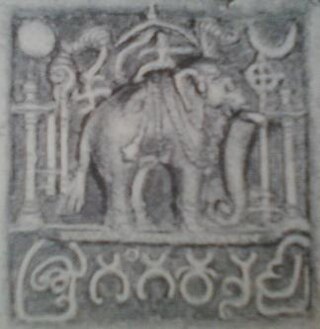Top Qs
Timeline
Chat
Perspective
Durvinita
Western Ganga King from 529 to 579 CE From Wikipedia, the free encyclopedia
Remove ads
Durvinita (r. 529 – 579 CE) is seen as the most successful ruler of the Western Ganga dynasty. He is remembered for his military prowess, literary achievements, and strong patronage of Jainism, and Son of The Previous King Avinita.
Durvinita's accession to the throne was disputed by his brother, who had gained the support of the Pallavas and Kadambas. There are Nallala and Kadagattur inscriptions that refer to this dispute. However, Durvinita managed to grab the throne by virtue of his valour.
Remove ads
Hostilities with Pallavas and Kadambas
During Durvinita's rule, the hostilities between the Pallavas and Gangas came to forefront and several pitched battles were fought by the two kingdoms. Durvinita defeated the Pallavas in the battle of Anderi. Though the Pallavas sought the assistance of the Kadambas to the north to tame Durvinita, the Gummareddipura inscription hails that Durvinita overcame his enemies at Alattur, Porulare and Pernagra. It is possible that these victories enabled him to extend his power over Kongudesa and Tondaimandalam regions of Tamil country.
Remove ads
Ties with Chalukyas
Durvinita was a clever king. In order to keep the Pallavas at bay, he gave his daughter to Chalukya Vijayaditya or from the Nagara record to Pulakesi II, though the latter is unlikely owing to the difference in their eras. The Chalukyas were an emerging power at this time. When the Pallavas attacked the Chalukyas, he fought on the Chalukya side and cemented a long lasting friendship with the Chalukyas that lasted through the rule of both the Badami Chalukyas, Rashtrakutas and Kalyani Chalukyas, covering a period of over 600 years. The Gummareddipura and the Uttanur plates describe Durvinita as the Lord of Punnata.
Remove ads
Religion
Durvinita was a devout follower of Jainism. Inscriptions suggest he patronized Jain monks of the Desiga-gana and Kundakunda traditions. Several Jain temples were established or supported under his reign.[1] His religious generosity is attested in records like the Madikeri copper plate inscription, where a Jain lineage tracing back to Gunachandra Bhattara is honored.[2]
Durvinita was a disciple of the Jain Acharya Pujyapada, and his court had several Jain scholars. Such tolerance was common among later Ganga kings, who actually took to Jainism in the later centuries.[3]
A 977 CE inscription states that Durvinita commissioned the construction of a Jain temple (basadi); the inscription records a grant by Indrakirti Munindra to this temple.[4]
Literature
Summarize
Perspective
Durvinita was a scholar and patronized several learned men, including his tutor Pujyapada.[5] According to Avanti-sundari-katha-sara, a work attributed to Dandin, Durvinita's court hosted the Sanskrit poet Bharavi for some time.[6] The Nallala grant inscription, issued during the 40th year of his reign, states that he was an expert at composing poetry, stories, dramas, and commentaries.[5]
Durvinita was a Jain and a learned scholar himself. During his reign, Durvinita is said to have engaged in public philosophical debates, where he reportedly defeated Buddhist scholars, reaffirming Jain philosophical dominance in the region. According to epigraphic sources, Durvinita’s court upheld Jain doctrines and he is the disciple of Acharya Pujyapada, who is believed to have led these debates. His victories in religious disputations further strengthened the status of Jainism in the Western Ganga kingdom and contributed to the gradual decline of Buddhist influence in parts of Karnataka.[7]
Durvinita was well-versed in Sanskrit and Kannada languages.[5] Amoghavarsha's Kannada-language text Kavirajamarga hails Durvinita as one of the early writers in Kannada prose, though no Kannada works by him survive.[6] According to multiple Ganga grant inscriptions, such as the Gummareddipura inscription, Durvinita wrote a Kannada-language commentary on Canto 15 of Bharavi's Kirātārjunīya.[8]
The Gummareddipura inscription and other Ganga inscriptions also suggest that he composed a Sanskrit version of Brihatkatha (Vadda-katha). These inscriptions also describe him as Shabdavatara-kara, suggesting that he composed the Shabdavatara (a work on grammar[9]). However, Shabdavatara is a work of his tutor Pujyapada.[8]
Remove ads
References
External links
Wikiwand - on
Seamless Wikipedia browsing. On steroids.
Remove ads
